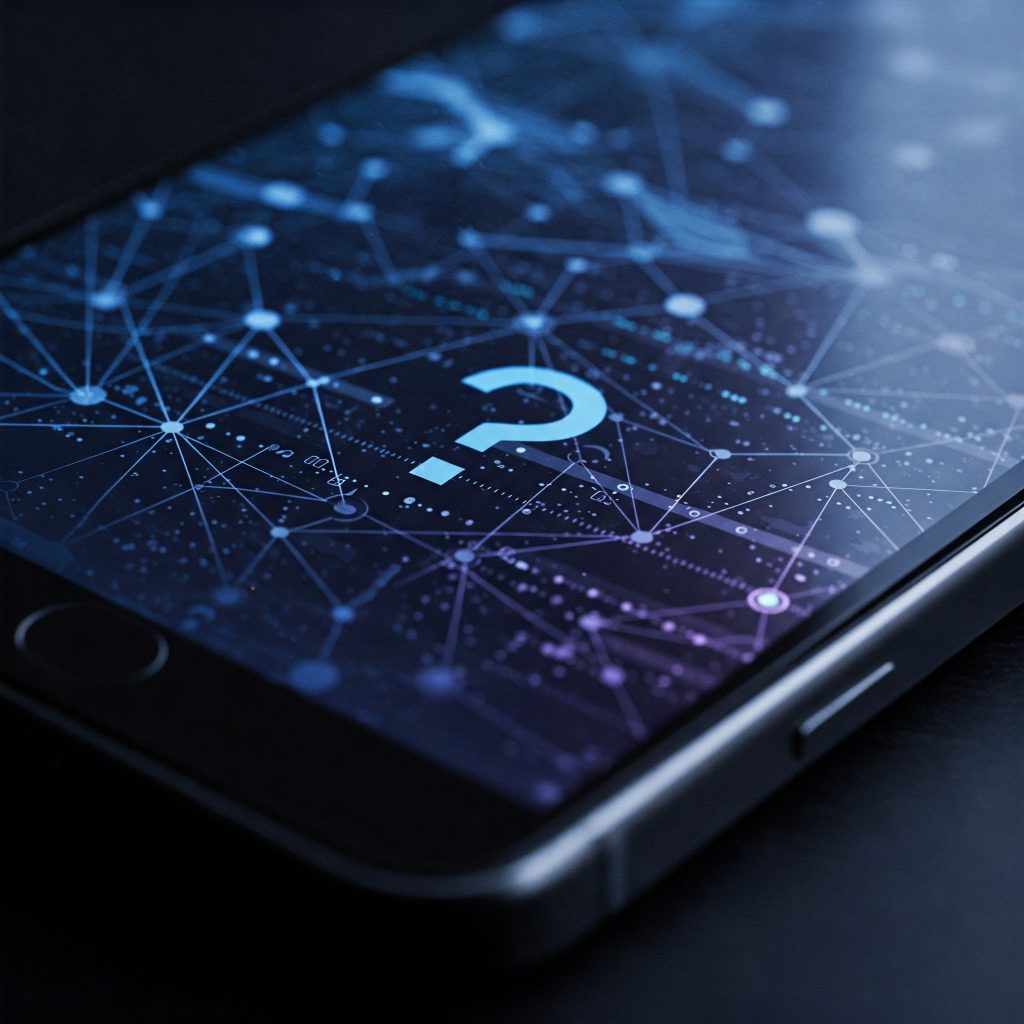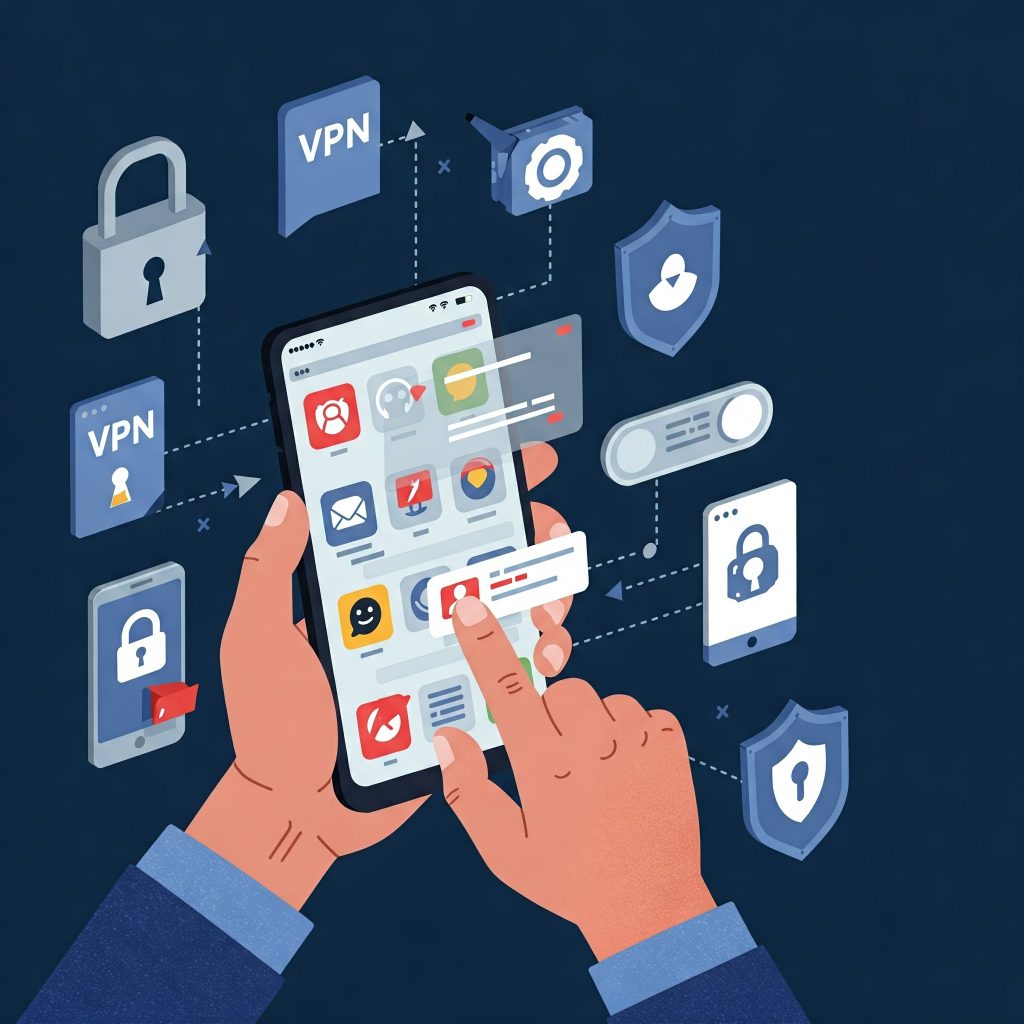Have you ever talked with your friend about a product—only to notice an ad for it on your cell phone seconds afterward? You didn’t search it up, you didn’t message anyone about it, and there it is on your Facebook page when you come back on seconds later. Coincidence? Your cell phone listening into your conversation?
This expanding trend evoked an understandable and unsettling question: Are we being secretly listened to by phones? Ubiquity of smartphones—following us everywhere and being constantly on—has created both valid fears and widespread misconceptions with this air of suspicion.
In an era of mass data mining and targeted advertising, this is no just an area of interest—it’s one of paramount importance at the crossroads of tech ethics, cybersecurity, and privacy. Discovering if your device is listening to you secretly without your awareness is more than a matter of paranoia; it’s one regarding your basic rights as an internet citizen.
In this article, we’ll separate fact from fiction on this question, dispel the technical myths surrounding today’s smartphones, review incidents and privacy issues reported and provide some specialized insight into what is occurring. Whether you are an anxious user or an IT professional, this guide will enable you to separate fear-mongering fantasy from evidence-supported fact.
The idea that smartphones are tapping into our ears undetected gained steam in the past ten years—fuelled by human reality rather than technical reports, by anecdote and viral tweets and the unsettling familiarity of online adverts. It is an intuition born out of everyday experience: people will describe offhand comment discussions on holiday destinations, pet food or settees and then notice eerily appropriate adverts some hours down the line. Such tales rarely include any hard facts to back them up and so sheer repetition and emotive power allowed mass doubt to develop.

Perception vs. Reality
Psychologically speaking, the human brain has an inbuilt tendency to find patterns that are not there to be found. The Baader-Meinhof phenomenon is this same psychological tendency. It psychologically primes you to notice something once it has come to your notice. Therefore, if you are discussing something like hiking boots and notice something similar being marketed somewhere else, your brain associates the two events when there is no relation between them. Both this phenomenon and the fact that everyone carries his/her cell phone and uses it anywhere make you experience an unsettling sensation that some person or something is following your actions all the time.
Social media has allowed these conspiracy theories to reach megaphone proportions. Platforms like Reddit, Twitter, and TikTok are replete with tales of phones spying on people, complete with screenshots of supposedly target-specific ads or app activity. People are well accustomed to hearing these stories and like to share them in anecdotal and viral form that further inflame public panic. They do not typically contain the technical context one needs to understand how contemporary data aggregation and ad targeting operate.
The Technical Facts and Marketing Rationale
Unlike surreal speculation to the contrary, all cybersecurity professionals and mobile operating system vendors (such as Apple and Google) agree there is no concrete evidence smartphones are covertly taping people in mass to market to them. The majority of mobile operating system environments require an explicit opt-in by an individual prior to allowing an application access to the microphone on an individual’s phone. Additionally, ongoing taping and processing on tens of millions of devices would pose technical and legal hurdles to surmount—not to mention pressing power and bandwidth requirements.
So how do these seemingly psychic ads do it? The answer is behavioral data. Advertisers don’t need to hear your chats to know what you’re seeking. Your browsing history, app use, whereabouts, social media behavior, and what you just scrolled past—these are all passed into advanced profiling algorithms. Data brokers gather this data from numerous sources and frequently correlate user behavior on numerous devices and platforms to create an informed opinion about your interests.
For example, if you are on outdoor gear websites, viewing hiking profiles on Instagram, or having recently gone to a national park, ad buyers can infer your interest in hiking and show you ads related to hiking gear—never requiring access to your microphone to do so.

Are Phones Really Listening?
To know if your cellular telephone can hear your conversation without your awareness, we need to examine the technical engineering used on modern mobile phones. As widespread as the fear of being listened to is, the reality about it is far more complex in the real world.
Microphone Permissions on Android and iOS
Both Android and iOS have evolved with user privacy at the forefront, and more so in current times. In order to access the microphone, any application must make an explicit request to the user during the install or runtime. It is usually preceded by an advisory message to the user explaining the type of access being sought.
Such system permissions are granular and revocable in newer versions of these operating systems. Users can see which apps are using the microphone and can revoke such permissions at any time they wish to. On top of this, most apps are limited to “while in use” access these days, and so are not permitted to turn on the microphone while in the background unless explicitly authorized—typically only voice-related services such as virtual assistants or communications apps.
Voice Assistants and Background Activity
Voice assistants like Siri, Google Assistant, and Amazon Alexa do, intentionally, attend to phrases like “Hey Siri” or “OK Google.” The function does need the equipment to employ a power-saving listening mode in which it is technically constantly “listening” for its wake word—but not recording or sending audio until it is triggered.
A temporary voice recording is created when the assistant is invoked and analyzed either on the local level or in the cloud, based on the devices’ settings. They are stored and can be retained for quality or machine learning purposes–but the user is usually notified and the big providers make it easy to access and delete past voice recordings.
That being noted, there has been the odd instance in the past when third-party developers attempted to exploit microphone access in the background. Such examples are extremely rare and are promptly stamped out by app store regulation, but they do highlight the need to examine app permission and be cautious with lesser-known developers.
OS-Level Security and App Sandboxing
Smartphones operate under stringent models of security like sandboxing—a system that isolates all apps within individual environments by prohibiting any unauthorized access to an application’s data or resources by any given application. It is among the underlying protection against malicious application efforts to exploit microphone access without the knowledge of the user.
Additionally, both Google and Apple enforce app control in their respective stores through both automated and human evaluation processes to detect malicious activity. Those apps found violating user privacy policies are suspended or compelled to update. Though these checks are implemented to some extent, the system is far from being impenetrable—adversaries continuously work to avoid detection and use obfuscation or exploits to bypass the system.
Acceptable Uses of Audio Access
Not all audio access is malicious. Many legitimate uses—such as video calls, voice messaging, or language learning apps—require access to the microphone. Access is explicit and to be expected and only to the app’s foreground activity in these kinds of instances.
Briefly, yes—phones can overhear, just not secretly without permission and not without some technical and regulatory hurdles to jump through. Mass covert audio surveillance is effectively impossible to perform through mobile operating system engineering, although random instances and vulnerabilities cannot be eliminated.

Myths and Misconceptions
All technological progress is accompanied by myths surrounding it. Smartphones “listening” to people are no exception to being surrounded by so much urban legend and myth based on anecdotal evidence and sensationalized fear. Below are the most widespread smartphone surveillance myths and the facts surrounding them.
Myth: All Apps Are Constantly Monitoring Private Discussions
The most prevalent myth is that all the apps are covertly listening to the consumers’ conversations and sending them to advertisers or tech companies. While this fear is mostly triggered by viral reports on people who overhear ads related to topics on which they had been discussing with others in private, this has made people believe that all the apps are covertly tapping into individuals’ everyday lives. The reality is very far from that.
While there are some apps, voice-enabled apps like Siri or Google Assistant, designed to deal with audio, most apps do not have the facility or requirement to continuously monitor audio all the time. Both platforms (iOS and Android) maintain explicit and open permission systems and no apps are allowed to access the microphone without an explicit user permission. Microphone use in the background is closely controlled and apps are not permitted to record covertly without user permission.
Additionally, app sandboxing restricts apps from accessing data from one app to another and thus minimizing the risk that audio recording can be secretly made. Although there are some instances of abuse, these are an exception and not the norm, and policies in the app stores are usually effective in catching this type of violation.
Myth: Microphone Access is Always the Cause of Targeted Ads
The popular belief that the ads one experiences on one’s devices are created through microphone eavesdropping is untrue. People believe that when one mentions something with regards to an item, the item’s ads will begin to show up on one’s devices. It does not work on the basis of how targeting is done in adverts.
Most adverts are founded on extensive profiling based on your location, search history, browser behavior, and app activity on social networks and so on. It makes more sense to develop an extensive user profile based on these bits and pieces rather than the nature of what you are talking about in one conversation alone. Advertisers and data brokers collect and examine this data and use advanced algorithms to display relevant adverts to you.
Also, most websites and software today track your cookies and your online trails and build an enduring portrait of your interests with the passage of time. It’s those chunks of data accrued with the passage of time—and not an individual instance of this exchange—that lead to your targeting ads. So far from an act of “coincidence” an ad appears following a conversation, it will most likely be an instance of captured data beforehand being used to forecast your interests.
Myth: Voice Assistants Turned Off Disable All Voice Monitoring
There’s an equally prevalent fallacy that simply turning off voice assistants like Siri or Google Assistant will put an end to all audio tracking behavior. While turning off voice-activated assistants like these will slow down the rate with which audio data can be garnered by these specific services, it won’t stop the remaining tracking that could still be going through some alternative medium.
Smartphones are equipped with an array of sensors and apps that produce data continuously. Usage patterns and location data, and even environmental conditions surrounding the user (such as the presence or absence of nearby Bluetooth devices), can be used to construct user profiles. Voice assistants can be switched off to avoid audio data capture but the phone can still capture huge amounts of data through other methods like application use and internet traffic.
How Metadata and Algorithms can Make it Seem like Eavesdropping
The reason so many people believe phones are listening to what you say is the eerily high accuracy of the algorithms powering digital advertising and recommenders. They can make very well-informed guesses about what you are interested in from what appears to be benign metadata: like when you are active, when you are located, your activity on your social networks, or what news articles you are reading.
This metadata in effect constructs nearly a more complete profile on you than an offhand conversation would. To provide an illustration, if you’ve been researching holidays, reading travel blogs on social networks, and checking out travel products on the internet, the algorithm will most likely ascertain that you are traveling—and begin to offer you with ads on hotels, flights, or travel bags. This predictive function can make your phone “listen” to you when in reality it’s simply making assumptions on patterns with your data.
Furthermore, algorithms can combine sources of data (for instance, location, Internet activity, and even the duration spent on single apps) to produce highly focused ads. It certainly can seem very clairvoyant with all this context targeting, but is so through careful monitoring of your online footprint—not through some sneaky audio recording of your voice.
Actual Hazards and Incident Reports
While the myth that phones are secretly listening to us is probably an exaggeration, there are genuine mobile privacy concerns to be thought about. They don’t come in the form of surreptitious bugging; rather in the form of data mining, privilege misuse by developers and third-party vendors and taking advantage of user trust. We’ll base ourselves on well-documented incidents and vulnerabilities that gave birth to real privacy consequences despite there being no audio monitoring in the world.
Examples of Past Offenses or Vulnerabilities
There are numerous instances in the past that involve apps misusing or going beyond the privileges assigned to them, most commonly to collect data without the user’s outright approval. The infiltrations were not in all instances about listening to what people are discussing, but still compromised user privacy in a significant way.
A prime example among these has been in 2018 when some well-known Android and iOS apps were found to be monitoring individuals through their microphones if not open on the user’s phone in an active state. It typically went under the radar of most users under the cover of in-app advertising or analytics service and not live audio monitoring but rather ongoing monitoring of microphone input to make deductions regarding the surrounding context—a user might be viewing an advertisement, attending a live concert, or simply conversing somewhere.
Similarly, in 2019, Facebook was under fire for covertly gathering user data with its VPN app called Onavo designed to provide users with protection and privacy on the internet. Subsequently, Facebook used the app to gather extensive user behavior data like websites accessed and actions on apps and sold this data to advertisers. Though this incident had no relevance to audio recordings, it was nevertheless an outright invasion of user privacy since users had entrusted the app with protecting data.

Collecting Data through Third-Party SDKs
The third-party software development kits (SDKs) are being used in addition to explicit app permissions as an important data harvester channel. Developers include an SDK within an application to offer functionality such as analytics, in-app payments, or ad capabilities. In most instances, the SDKs will collect more data than intended or delegated without user awareness.
For example, it came to light in 2017 that some mobile apps were using SDKs to collect users’ locations and other personal data without proper disclosure. A prime example was an SDK called Analytics used by some popular apps. The SDK existed to track user behavior, when in fact it was accessing users’ locational data and other personal data and reshipping it to third-party servers. Users had not given explicit agreement to the collection of this personal data, but the SDKs allowed it to be gathered and sold on to others.
Tiktok has more recently come under fire for its use of third-party SDKs and the way that data created by such third-party providers can be routed to unauthorized individuals. The application itself does not spy on its users, but the third-party providers that it employs can cause unregulated data exchange and raise issues regarding data breach and unauthorized monitoring.
There are instances when Users’ trust has been breached without audio recordings
Most disconcerting in the past years has been the increased involvement in duplicitous or obscure data practices that undermine user trust. Numerous apps and services are siphoning an alarming level of personal data, sometimes without users’ explicit permission or without transparency to users regarding the extent of data gathering activities. The practices can provide users with an erroneous impression of privacy protection when the darker reality is far more intrusive.
A series of privacy breaches in 2019 were perpetrated by a popular fitness tracker application. The app’s terms and conditions were not made explicit and came to light when it transpired that users’ data—locations, exercise routines, and health data—was being sold to third-party corporations to be used in ads. The violation wasn’t one of call recording, but it was one with the maximum invasion of user privacy and trust. Users had wished that their individual data, such as exercise routines or health data, would be protected and instead used to make profits without making them fully aware about it.
Also making headlines are Facebook and Google, two online behemoths that have been in the middle of several scandals regarding the misuse of private data. In all instances, it wasn’t corporations tapping one’s conversation but the way the websites used private data in ways users hadn’t explicitly agreed to. Whether it was the Cambridge Analytica debacle or revelations regarding Google’s location tracking, these instances showed ways the relied-upon websites could invade privacy without ever having to reach the microphone.
The Role of Data Brokers and Big Tech
In contemporary society, data has been referred to as the “new oil.” Collection and processing and analyzing personal data form the basis to an incredible extent on which big businesses and particularly the tech majors conduct operations on. Although the majority of the collections are lawful, it has extensive implications on privacy, acceptability by users, and overall issues related to personal security. Here, we explain how data brokers and the tech majors collect and leverage behavioral and context data and engage in profiling consumers with the aim to advertise to them.
How Companies Collect Behavior and Contextual Data Legally
The epicenter of today’s advertising is the aggregation of huge amounts of behavioral and context data. Technology giants Google, Facebook, Amazon, and Apple through all their products and services capture huge amounts of user data that are then used to deliver extremely personalized experiences and advertising.
The methods by which data are accumulated are legion and, in most cases, legitimate, if too often based on an elaborate system of terms of service and privacy notices never read to the bottom or understood by consumers. The data gathering takes place whenever an individual uses an internet service—surfing the internet, logging on to some form of social media, buying something online, or chatting with one of the voice assistants.
For example, when you search on Google, or when you log into Facebook to access your social media account, your search and behavior are tracked and used to build you a user profile. Your behavior generates behavior data, and businesses use this data to better know your preferences, routines, and choices.
Further, location tracking has become one of the prominent means by which to gather contextually relevant data. As long as your location services are activated on your cellphone, businesses can track going to and remaining somewhere and then make an inference about your lifestyle—i.e., your daily trip to and from your job, your shopping patterns, your political or ideological orientations—and target you with highly pertinent ads based on that.
Profiling Based on Search History, Location, Mobile Application Usage, and More
The data gleaned from users is not just about individual pieces of activity—it’s about constructing an integrated image out of an immense array of data points. Some of the most commonly gleaned categories of data are:
• Search History: Every search you perform on an internet search site like Google contributes to an extensive profile of your interests, requirements, and inclinations. Not only is this used to offer you more suitable search findings, but it is used to offer focused adverts based on your interests too.
• Location Data: Companies track your whereabouts using your phone’s GPS or your IP address and apply geolocation to it. It allows them to serve location-targeted ads like advertising nearby businesses or offering special offers when you are nearby an outlet. Location data is more intrusively used to ascertain lifestyles or make predictions on behavior patterns.
• App Usage: Every app that you download and use generates data on your use of the same. Developers monitor how often you use an application and which features you use and for how long you are in an application. All this data can then be aggregated from several apps to build an extremely comprehensive user profile.
• Social Media Engagement: Social networking platforms gather a tremendous amount of data not just from what you say, but from who you converse with, what you view, and who you “like” and comment on. This allows businesses to know not just what you hold interest in, but your friends, political leanings, and personal beliefs.
Through the aggregation of all these points of data, businesses are able to construct comprehensive, multi-faceted user profiles. They then use these to make predictions about user behavior and provide businesses with the ability to target advertising with an unparalleled level of accuracy.
Advertising Algorithms and Predictive Analysis
Once the data has been accrued, it is entered into highly advanced ad algorithms that are designed to calculate what you would be interested in well in advance before you are actually aware yourself. The algorithms use predictive analysis to ascertain your likelihood to engage with products and services from your past behavior.
For instance, if you’ve been on travel websites sorting out your vacation trip, your account can prompt an algorithm to make an inference that you’re planning to purchase an airplane ticket or accommodation booking. As a result, travel ads begin to show up on your newsfeed, sometimes even prior to making up your mind or taking further action.
The actual implication is that these algorithms can generate highly personalized experiences from past and real-time data. The more devices you have and the more you utilize them, the algorithms adapt and modify their predictions on an ongoing basis to help streamline the advertisements that you view. Over time, these algorithms can pick up on your interests and the advertisements you view become increasingly targeted to your interests.
This predictive targeting is especially strong in verticals like retail, travel, and finance, in which consumers’ buying behavior may be affected by seemingly minor changes in context, location, or individual interest.
Additionally, this type of predictive insight doesn’t just identify products by user interest – it actually has the ability to forecast the state and intentions of the user at the very moment. As an example, if someone is accessing social networking late at night, an algorithm can assume that this user will be more likely to make an impulsive purchase and show them late-night shopping deals.

How to Protect Yourself
While smartphone tracking and data gathering sounds foreboding, there are genuine and straightforward measures you can adopt to protect your privacy and prevent your personal data from being unnecessarily shared. You can dramatically reduce the risk of unnecessary tracking and misuse of data by checking app permissions, employing privacy-friendly technologies, and exercising vigilance when downloading apps. Here are some pragmatic tips on how to maintain your privacy in today’s smartphone world with data monitoring:
Auditing and Permission Management of Apps
One of the simpler and more effective methods to shield yourself from unsolicited data collection is to maintain regular checks and audits on app permissions. Various newer smartphones, both the Android type and iPhone models, provide users with the provision to control what data and function an application can access. A few examples are access to the microphone, camera, location services, and contact list.
To manage application permissions:
1. Permissions Audits: Periodically audit the permissions on all apps. Both Android and iOS have options to see what the apps are accessing. You can see who has access to your location and microphone and turn off any that you don’t believe should be allowed to access these features.
2. Restrict Unnecessary Permissions: Be careful when granting permissions when downloading apps. Your weather app does not need to know your contacts and your game app will not need to know your location. Grant only those permissions required by the application to run effectively.
3. Disable background access: Even when not in use, most apps continue to collect data. Both on Android and iOS devices, you can disable background app refreshes and location services separately on individual apps so that these apps collect data when you are using them actively.
You can avoid apps accessing your microphone, location, or camera without your explicit permission by checking app permissions daily.
Disabling Unnecessary Microphone and Location Access
The worst aspect regarding smartphone privacy is that the apps can obtain your location or microphone access without your notice or explicit permission. While some apps genuinely require these privileges to function properly, others exploit them to make money from either behavioral profiling or target advertising.
To protect your privacy:
• Disable microphone access to apps that don’t require it. For example, gaming apps or social networking apps may request microphone access, but most apps don’t require microphone access to function properly. Disable microphone access to any app that does not require it.
• Limit location tracking to apps that are required, such as mapping apps or navigation apps. If an app needs access to your location but does not require this to fulfill its main function (such as an audio app or game), you can refuse this permission so that it is not able to track you.
• Where possible, utilize temporary permissions. In software that requires microphone or location access to perform some activities (voice assistants or ride hailing apps), utilize temporary permissions to provide access only when the application is in use.
You reduce the risk of unauthorized spying considerably by restricting unnecessary access to your microphone and location.
Using Privacy-Focused Operating Systems or Applications
They also include privacy-focused software and privacy-centered operating systems designed with protection and security of data in mind that individuals who are very privacy-conscious can take advantage of. They value your data privacy like no one else and provide you more control regarding what is shared.
1. Privacy-Focused Operating Systems:
- GrapheneOS (Android) and CalyxOS are two solid replacements to stock Android with improved privacy features like secure encryption with more control on app permission and lowered data collection.
- On the iPhone platform, you benefit from the built-in features like privacy labeling on the App Store that provide you with transparency into what data is being collected by the apps.
2. Privacy-Focused Apps:
- Use privacy-friendly internet browsers like Brave or Firefox Focus to access the internet by blocking third-party trackers and ads.
- For messaging, use Signal or Telegram, both with end-to-end encryption and no retention of user data.
- For searching, DuckDuckGo provides private and non-tracked search results in contrast to Google or any search engine that tracks and personalizes search history.
Through these privacy-centric features you are able to restrict your exposure to data collection and exercise greater control over your own data.
Being Cautious of Apps from Untrusted Developers
One more important step to protect your privacy is to be careful when downloading software onto your mobile. Programs created by unethical developers will do all sorts of harmful things, ranging from gathering personal details to hiding spy software.
To Protect Yourself:
- Read Reviews and Ratings on the App: Before downloading an app, read reviews and ratings on Google Play or the App Store. Look out for any sign of malicious activity, like if others are reporting that the app is collecting data without permission or otherwise misbehaving.
- Downloading from Reputable Sources only: Mobile apps should be downloaded from reputable sources like the Apple App Store or Google Play Store. Avoid third-party websites because the apps on these websites might not be vetted for privacy and security.
- Research the Developer: Research the developer before you download an app. An app created by an established well-known company will usually be more secure compared to one programmed by unidentified or untested developers. Try to discern if there is any data on the developer’s data use policies or its privacy practices.
- Keep Your Apps Updated: Having your apps up to date ensures that any vulnerability is patched. App developers release updates to patch security vulnerabilities or solve privacy problems.
You can prevent your privacy from being exposed by being careful in choosing apps and knowing the present threats by being attentive not to download malware or unsafe software inadvertently.
Legal and Expert Opinions
Among data privacy and cybersecurity specialists are attorneys who provide insightful commentary on the ongoing concerns surrounding smartphone tracking and data aggregation. As user activity came to be traced more extensively through capabilities afforded by technology, so likewise does it pose significant ethical and legal questions on privacy rights, data integrity, and user permission. Here we summarize opinion among cybersecurity specialists on the matter, examine relevant legislation, and provide some overview on legal gray areas encompassing passive data gathering.
Quotes and Views by Cybersecurity Professionals
Cybersecurity experts warned long ago about the risks of passive data gathering through internet platforms and smartphones. Privacy has become “the new frontier of cybersecurity these days,” according to Eugene Kaspersky, the CEO-founder of Kaspersky Lab, and individuals and organisations should guard against their data and its potential misuse.
World-leading cybersecurity expert Bruce Schneier has stated, “Surveillance is an inevitable byproduct of advanced technology. The only question is not if we will be surveilled, it’s how will we control and regulate it.” Schneier’s work makes it clear that while technological surveillance is certainly not disappearing anytime soon, individuals can nevertheless resist the dangers by employing privacy-conscious behaviors and security measures.
Experts further warn that data gathering regardless of how it is framed in the interest of convenience has the potential to have unexpected consequences. Cybersecurity expert Dr. Jessica Barker continues, “Personal data collection by smartphones is usually accomplished without the users being completely aware of what the implications are. Some data collection is potentially helpful, but many instances are accomplished in ways that expose users to third-party advertisers and potentially to criminals.”

Overview of Relevant Regulations (e.g., GDPR, CCPA)
As the privacy and data protection concerns rise globally, several regulatory frameworks are put in place to protect individuals’ personal data. The regulatory frameworks set standards on how businesses acquire, maintain, and use consumers’ data to protect people from exploitation and misuse.
- General Data Protection Regulation (GDPR):
Enacted by the European Union in 2018, the GDPR is one of the most extensive data protection laws worldwide. The GDPR imposes strong rules on how businesses collect, store, and process personal data. The GDPR compels businesses to obtain explicit consent to collect personal data and provide users with the right to request erasure and access to one’s personal data whenever they make the same. The regulation demands that the users be informed regarding what data is being collected and the reason behind the same.
While the GDPR primarily concerns EU enterprises, it does touch on enterprises outside the EU that deal with data belonging to EU residents. The regulation has had an impact on the way tech firms function and has encouraged them to adopt privacy-by-design practices and professionalize data handling.
- California Consumer Privacy Act (CCPA):
Similar to the GDPR, the CCPA, signed into law in 2020, is an American state law protecting consumers’ privacy. The CCPA entitles California consumers to know what personal data is being collected, to request erasure of their data, and to opt out of the sale of their personal data. The CCPA does not demand affirmative consent to collect data like with the GDPR does but demands explicit disclosure of data practices by firms.
The CCPA allows consumers greater control of their own individual data, especially regarding advertising and data brokers who collect and sell huge amounts of data to third parties. - Other International Regulations:
Besides the CCPA and GDPR, there are other nations that are implementing or have implemented similar data protection laws like the LGPD in Brazil, the PDPB in India, and the PIPEDA in Canada. They seek to provide consumers with more transparency, rights, and control of their personal data to make tech firms more responsible for collecting and processing data.
The Legal Gray Areas of Passive Data Collection
There exist significant legal loopholes in passive data gathering despite the above mentioned regulations. Many firms make use of advanced data gathering methods without clearly approaching users and requesting permission to do so. As an illustration, tracking cookies, metadata and even device fingerprinting can be used to gather data passively and it is difficult to make users aware exactly what is being gathered and by who.
- Implicit Consent:
Implicit consent occurs in some jurisdictions when an application or service is accessed by the user without explicit assent to data capture on their part. Consent to site conditions, for example, may be sufficient to authorize tracking user behavior through the use of cookies or passive methods. The practice is nevertheless increasingly under scrutiny because users may not fully know what it is they are agreeing to when hitting the “accept” button on an Internet site. - Share of Third:
Most websites and apps forward user data to third-party ad networks or data brokers without revealing it to the users. The data broker economy is situated in the gray area and outside the law in so far as customers are not aware that their data are being compiled and sold and analyzed. Despite regulatory safeguards like GDPR and CCPA, third-party data exchange is hard to monitor under the law with firms hiding behind complex and impenetrable privacy policies. - Passive Voice Assistant Surveillance:
Even when voice assistants like Siri, Google Assistant, and Alexa are intended to simplify the lives of the users, there are legal issues with passive data gathering that the assistants undertake. The assistants are constantly ready to receive the call command, and most of the users are not aware that voice interaction with the assistants is being recorded and potentially analyzed by the providing companies. Although most of the major tech firms provide options to limit the recording and saving of voice data, the practices are dubious on the basis that they are passive monitoring and storing personal discussions.
As we’ve set out in this article, whether your smartphone is listening to you or not is something that is only in your imagination—there is no large-scale evidence that smartphones are actively recording private conversations. The actual concerns at hand when it comes to privacy, data collection, and surveillance actually do exist. While one must be careful not to confuse paranoia with sound judgment, one does need to stay on one’s toes in an ever data-dependent world.
No Evidence of Widespread Eavesdropping, but Privacy Concerns Are Legitimate
While the concept of our dialogues being surreptitiously recorded by smartphones is disconcerting one, evidence to date points to more mundane explanations for the increased use of personalized ads. Smartphones’ mics are sound-sensitive, but there is no indication that apps are continuously recording and monitoring people. Instead, targeting and personalization are most probably due to behavioral data and internet histories and location monitoring—data that people gladly provide by way of app use and interaction.
Even without mass eavesdropping to worry about, privacy concerns are not to be downplayed. Data gathering — and this includes passive methods like tracking cookies or more engaged methods like assistant voice use — raises real concerns to individual privacy and to security. As more behavioral data are made available to tech firms to monitor, even if audio snooping itself is not the biggest problem, the risks are significant.
Difference Between Paranoia and Informed Prudence
Individuals need to know the difference between being tech paranoid and being informed cautious. Paranoia would cause people to believe that everyone and any software or service on the internet is spying on them and it is just not so. Being informed cautious is being aware of what can go wrong with the newest tech and doing something to safeguard your privacy.
Individuals will be able to control their own decisions about what to share by learning how voice assistant data storage and third-party data exchange work and how targeted advertising operates. Acting negligently with app permissions, privacy controls, and selective data disclosure is not coddling fear but assuming control over one’s own data in an interconnected, online world.
Concluding Thoughts regarding Digital Literacy and Continued Watchfulness
Now that our digital existence is increasingly intertwined with our mobile devices, it is more important than ever to be digitally literate. This means knowing how our data is being used, understanding the risks of digital surveillance, and being aware of how to protect ourselves by making smart choices regarding permissions, security settings, and privacy policies.
Being vigilant does not involve merely blocking microphone access and not taking personal ads. It entails familiarity with legal privacy protection like the GDPR and CCPA and demanding more regulation and transparency from tech companies. It demands monitoring new threats and being current with the rapidly evolving arena of cybersecurity and data protection too. Briefly put, smartphones are certainly not listening to you in the literal way that most conspiracy theories will convince you otherwise, but the overarching issue of privacy and data exploitation is very real. If we remain informed, watchful, and active, we can safely move through this complicated world online with conviction and protect our own data from those who would exploit it.




